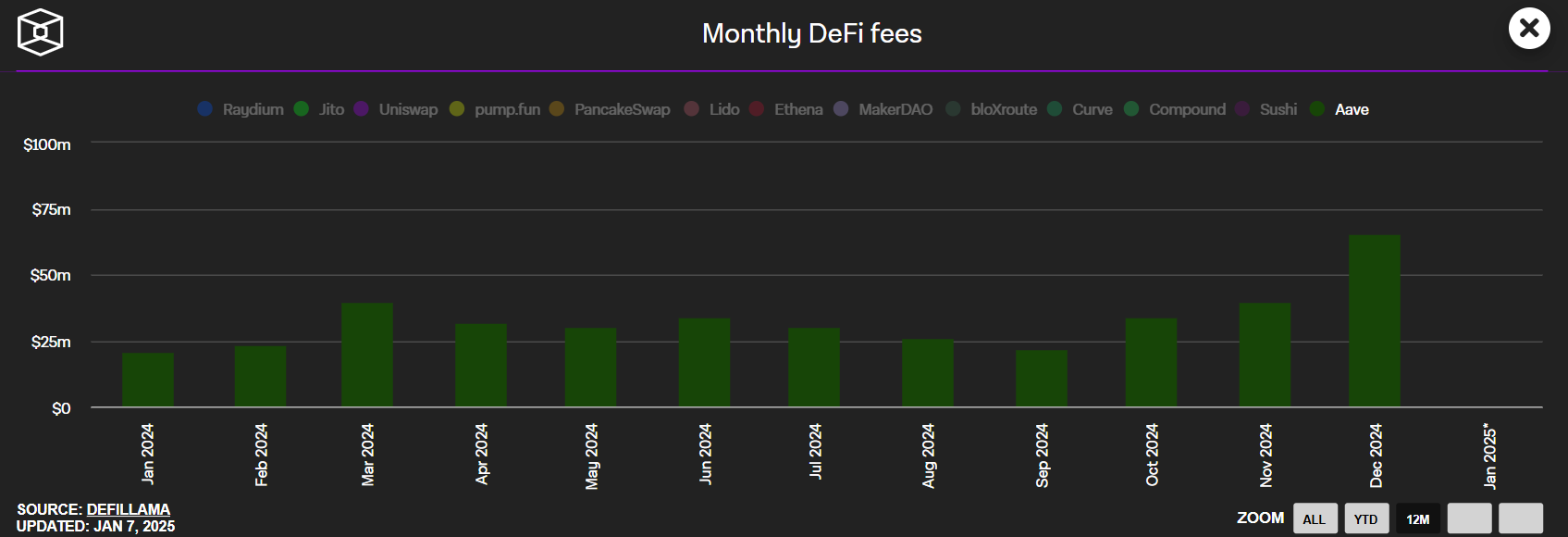- Aave Labs announced the deployment of its V3 on the Aptos testnet, marking its first non-EVM integration.
- The testnet process aims to evaluate Aave V3's security and performance on Aptos ahead of a potential Mainnet launch.
- AAVE is down nearly 10% in the past 24 hours.
AAVE declined nearly 10% on Tuesday despite deploying its V3 software on the Aptos testnet, marking its first-ever non-Ethereum Virtual Machine (EVM) integration.
AAVE declines despite integrating its lending protocol on Aptos testnet
Aave Labs launched its decentralized lending protocol, Aave v3, on the Aptos testnet following an announcement on its governance platform. This marks the protocol's first non-EVM integration, leveraging Aptos's Move programming language for its v3 functionality.
With the testnet phase, Aave aims to evaluate the reliability, security, and efficiency of Aave V3 on Aptos before considering a potential Mainnet launch.
"Aave Labs will leverage the testnet phase to rigorously validate the Move implementation of Aave V3's safety, stability, and performance before the Mainnet launch, subject to governance approval," Aave Labs stated.
The deployment on Aptos also requires a partnership with the decentralized oracle network Chainlink for a production-ready price feed upon its Mainnet launch.
The partnership between Aave and Aptos dates back to July 2024, when the Aptos Foundation's temperature check (TEMP CHECK) governance proposal on Aave's V3 software deployment on its chain received approval from its community.
After testing, the proposal will advance to the Aave Request for Comments (ARFC) stage for further assessment. If endorsed at this stage, it will move to the Aave Improvement Proposal (AIP) phase for the governance team's final review and approval.
Meanwhile, AAVE witnessed double-digit losses of 10% in the past 24 hours following the general crypto market decline. This could be a temporary pullback before the lending token continues its impressive record over the past months, as its price is still up by over 210% on the yearly timeframe.
According to The Block's data page, Aave witnessed significant growth in 2024, with its revenue reaching $60.9 million in December, just near its 2021 peak of $65.39 million. During the year, the protocol generated $389 million in fees, with an average of $32.4 million per month — a 14% monthly growth rate.
Aave Monthly Fees. Source: The Block
If Aave continues generating high revenue in the coming months, it could boost investors' appeal for its token.
Cryptocurrency metrics FAQs
The developer or creator of each cryptocurrency decides on the total number of tokens that can be minted or issued. Only a certain number of these assets can be minted by mining, staking or other mechanisms. This is defined by the algorithm of the underlying blockchain technology. On the other hand, circulating supply can also be decreased via actions such as burning tokens, or mistakenly sending assets to addresses of other incompatible blockchains.
Market capitalization is the result of multiplying the circulating supply of a certain asset by the asset’s current market value.
Trading volume refers to the total number of tokens for a specific asset that has been transacted or exchanged between buyers and sellers within set trading hours, for example, 24 hours. It is used to gauge market sentiment, this metric combines all volumes on centralized exchanges and decentralized exchanges. Increasing trading volume often denotes the demand for a certain asset as more people are buying and selling the cryptocurrency.
Funding rates are a concept designed to encourage traders to take positions and ensure perpetual contract prices match spot markets. It defines a mechanism by exchanges to ensure that future prices and index prices periodic payments regularly converge. When the funding rate is positive, the price of the perpetual contract is higher than the mark price. This means traders who are bullish and have opened long positions pay traders who are in short positions. On the other hand, a negative funding rate means perpetual prices are below the mark price, and hence traders with short positions pay traders who have opened long positions.
Information on these pages contains forward-looking statements that involve risks and uncertainties. Markets and instruments profiled on this page are for informational purposes only and should not in any way come across as a recommendation to buy or sell in these assets. You should do your own thorough research before making any investment decisions. FXStreet does not in any way guarantee that this information is free from mistakes, errors, or material misstatements. It also does not guarantee that this information is of a timely nature. Investing in Open Markets involves a great deal of risk, including the loss of all or a portion of your investment, as well as emotional distress. All risks, losses and costs associated with investing, including total loss of principal, are your responsibility. The views and opinions expressed in this article are those of the authors and do not necessarily reflect the official policy or position of FXStreet nor its advertisers. The author will not be held responsible for information that is found at the end of links posted on this page.
If not otherwise explicitly mentioned in the body of the article, at the time of writing, the author has no position in any stock mentioned in this article and no business relationship with any company mentioned. The author has not received compensation for writing this article, other than from FXStreet.
FXStreet and the author do not provide personalized recommendations. The author makes no representations as to the accuracy, completeness, or suitability of this information. FXStreet and the author will not be liable for any errors, omissions or any losses, injuries or damages arising from this information and its display or use. Errors and omissions excepted.
The author and FXStreet are not registered investment advisors and nothing in this article is intended to be investment advice.
Recommended Content
Editors’ Picks

Litecoin Price Forecast: 40,000 LTC traders exit as crypto crash triggers $500M in liquidations
Litecoin price slid 10% to hit a 7-day low of $102 on Wednesday. On-chain metrics show a large number of LTC holders exiting their positions as hawkish US jobs data sparked downward volatility.

Bitcoin edges below $96,000, wiping over leveraged traders
Bitcoin's price continues to edge lower, trading below the $96,000 level on Wednesday after declining more than 5% the previous day. The recent price decline has triggered a wave of liquidations across the crypto market, resulting in $694.11 million in total liquidations in the last 24 hours.

DOGE and SHIB traders book profits at the top
Dogecoin and Shiba Inu prices broke below their key support levels on Wednesday after declining more than 9% the previous day. On-chain data provider Santiments Network Realized Profit/Loss indicator shows massive spikes in these dog-theme memecoins, indicating traders realize profits.

Top 3 Price Prediction Bitcoin, Ethereum, Ripple: Over $560 million in liquidation
Bitcoin (BTC) hovers around $97,000 on Wednesday after declining more than 5% the previous day. Ethereum (ETH) and Ripple (XRP) follow in BTC’s footsteps and decline 8.3% and 6.15% respectively.

Bitcoin: 2025 outlook brightens on expectations of US pro-crypto policy
Bitcoin price has surged more than 140% in 2024, reaching the $100K milestone in early December. The rally was driven by the launch of Bitcoin Spot ETFs in January and the reduced supply following the fourth halving event in April.

Best Forex Brokers with Low Spreads
VERIFIED Low spreads are crucial for reducing trading costs. Explore top Forex brokers offering competitive spreads and high leverage. Compare options for EUR/USD, GBP/USD, USD/JPY, and Gold.
